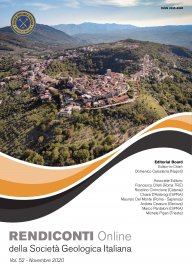
Digital photogrammetric analysis approaches for the realization of detailed terrain models
Antonio Minervino Amodio (1), Pietro P.C. Aucelli (2), Vittorio Garfì (1) & Carmen M. Rosskopf (1)
(1) University of Molise, Department of Biosciences and Territory, 86090, Pesche (IS), Italy.
(1) University of Naples "Parthenope", Department of Science and Technology, 80121 Naples (NA), Italy. Running head: Photogrammetric analysis for DTM realization
Corresponding author e-mail: a.minervinoamodio@studenti.unimol.it
Volume: 52/2020
Pages: 69-75
Abstract
Digital Surface Models (DSMs) with a high spatial resolution and accuracy are of increasing importance for many applications. Recent advances in data acquisition technologies, such as those related to the use of Unmanned Aerial Vehicles (UAVs), enabled the acquisition of images suitable to generate high-resolution DSMs. The present study aims to provide useful indications for data acquisition and processing to obtain DSMs with small errors by using the Structure from Motion (SfM) algorithm. We changed three parameters during data acquisition (flight height, camera type and acquisition mode) and used four different interpolation methods in the elaboration phase (Inverse Distance Weighted - IDW, IDW ArcGIS, Triangular Irregular Network – TIN, and Topo to Raster). Obtained results highlight the advantage to use the IDW method for data interpolation and for areas of various surface in combination with different flight heights as follows: i) for areas smaller than 0.1 ha, a flight altitude of 5 meters is advisable; ii) for areas between 0.1 and 1 ha, a flight altitude of 15 meters is advisable; iii) for areas larger than 1 ha, the most convenient flight altitude is 30 meters. Our workflow can also be followed by different tools (RGB cameras, light detection and ranging - LIDAR) to obtain the best DSMs accuracy.
Keywords
Digital Surface Models (DSMs), Structure from Motion (SfM), Unmanned Aerial Vehicle (UAV), Measurement of soil erosion features.
Get Full Text